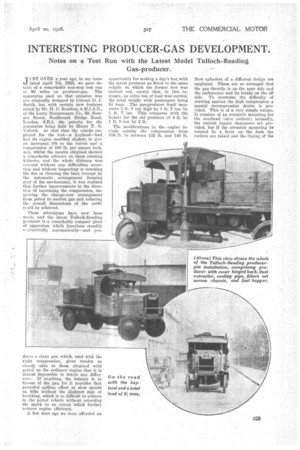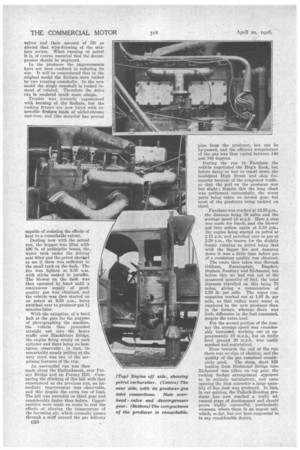INTERESTING PRODUCER-GAS DEVELOPMENT.
Page 13

Page 14

If you've noticed an error in this article please click here to report it so we can fix it.
Notes on a Test Run with the Latest Model Tulloch-Reading Gas-producer.
JUST OVER a year ago, in our issue dated April 7th, 1926, we gave details of a remarkable non-stop test run of 90 miles 'on producer-gas. The apparatus used on that occasion was one originally designed by Colonel D. ,T. Smith, but with certain new features added by Mr. H. C. Reading, A.M.I.A.E., of the Lorry Maintenance Co., GS, Sumner Street, Southwark Bridge Road, London, S.E.1, the patents for the apparatus being held by Major T. G. Tel:loch. At that time the vehicle employed for the test—a Leyland—had had its engine modified slightly to give an increased lift to the valves and a compression of 100 lb. per square inch, and, whilst the results obtained showed a remarkable advance on those existing hitherto, and the whole distance was covered without any difficulties occurring and without inspecting or touching the fire or cleaning the bars (except by the automatic arrangement forming part of the mechanism), it was realized that further improvements in the direction of increasing the compression, improving the change-over arrangement from petrol to suction gas and reducing the overall dimensions of the outfit could be achieved.
These alterations have now been made, and the latest Tulloch-Reading producer is a remarkably compact piece ^ of apparatus, which functions steadilr —practically automatically—and pro duce=s a clean gas, which, used with the right compression, gives results so closely akin to those obtained with petrol on the ordinary engine that it is almost iinpossible to detect any difference. If anything, the balance is in favour of the gas, for it provides that powerful pulling effect at slow speeds on hills without the slightest sign of knocking, which is so difficult to achieve in The petrol vehicle without retarding the spark to an extent which further reduces engine efficiency.
A few days ago we were afforded an
opportunity for making a day's test with the latest producer as fitted to the same vehicle on which the former, test was carried out, except that, in this instance, an extra ton of load was carried, the total weight with passengers being 814 tons. The gas-producer itself measures 3 it. S ins, high by 1 ft, 7 ins. by 1 ft. 7 ins. This compares with the , figures for the old producer of 4 ft. by 1 ft. Sins. by 2 ft.
The modifications in the engine in. elude raisifig the compression from 100 lb. to between 135 lb. and 140 lb. New cylinders of a different design are employed. These are so arranged that the gas throttle is on the near side and the carburetter and its intake on the off side. To overcome the difficulty of starting against the high compression a special decompression device is provided. This is of a very simple nature. It consists of an eccentric mounting-for the overhead valve rockers; normally, the correct tappet clearances are provided, but if the eccentric mounting be rotated by a. lever on the dash the rockers are raised and the timing of the Valves and their amount of lift so altered that wire-drawing of the miXtare occurs. When running on petrol it is, of course, essential that the decornpressor should be employed.
In the producer the improvements have not been confined to reducing its size. It will be remembered that in the original model the firebars were rocked by two rotating camshafts. In the new model the single camshaft is rocked instead of rotated. Therefore the drive can be rendered much more simple.
Trouble was formerly experienced with burning of the firebars, but the rockg frames are now faced with renewable firebars made of nickel-chrome east-iron, and this material has proved
capable of resisting the effects of heat to a remarkable extent. •
Dealing now with the actual test, the hopper was filled with 196 lb. of anthracite beans, the. water tank under the driving seat filled and the petrol checked to see if there was sufficient in the small tank on the dash. The fire was lighted at 9.35 a.m. with sticks soaked in paraffin. The blower on the dash was then operated by hand until a Continuous supply of goodquality gas was obtained, and the vehicle was then started up on petrol at 9.55 a.m., being switched over to producer-gas 1i minutes later.
With the exception of a brief halt at the gate for the purpdse of photographing the machine, the vehicle then proceeded straight out into the heavy traffic over Blackfriars Bridge, the engine firing evenly on each cylinder and there being no hesitation observable ; in fact, its remarkably steady pulling at the very start was one of the surprising features of the trip.
Au uneventful run was then made along the Embankment, over Putney Bridge and up Putney Hill. Comparing the climbing of this hill with that experienced on the previous run, an immediate improvement was observable, and this despite the extra ton of load. The hill was ascended on third gear and considerably faster than before. Opportunities were made en route to test the effects of altering the temperature of the incoming air, which normally passes through a muff around the gas delivery pipe from the producer, but can be by-passed, and the efficient temperature of the gas was thus varied between 140 and 180 degrees.
During the run to Farnham the vehicle negotiated the Hog's Back, but before doing so had to crawl down the Guildford High Street and stop frequently because of the congested traffic, so that the pull on the producer was but slight ; despite this the long climb was performed successfully, the worst parts being taken on second gear, but most of the gradients being tackled on third.
Farnham was reached at 12.55 p.m., the distance being 39 miles and the average speed 13 m.p.h. Here a stop was made for lunch, and the blower put into action again at 2.10 p.m., the engine being started on petrol at 2.15 p.m. and switched over to gas at 2.20 p.m., the reason for the slightly longer running on petrol being that with the bigger fire and damping down it was a little time before gas of a consistent quality was obtained.
The route then taken was through Odiham, Sunningdale, Bagshot, Staines, Sunbury and Richmond, but before this we had -run out of the measured quantity of fuel, the total distance travelled on this being 72 miles, giving a consumption of 2.58 lb. per mile. The water consumption worked out at 1.87 lb. per mile, so that rather more water is employed in the new producer than in the former, whereas there was little difference in the fuel consumed, despite the extra load.
For the second portion of the journey the average speed was considerably increased, working out at approximately 16 m.p.h.„ but on fairly level ground 20 m.p.h. was easily reached and maintained.
Even towards the end of the run there was no sign of choking' and the quality of the gas remained consist ently good. The steep, short hill leading from Richmond Bridge into Richmond was taken on top gear, the rocking firebar arrangement appeared to be entirely satisfactory, and upon openinv' the dust extractor a large quantity of fine dust was produced. In fact, in our opinion, the Tulloch-Reading producer has now reached a really advanced stage of development and should prove highly sueeessfol, particularly overseas, where there is an urgent call, which, so far, has not been responded to in any considerable degree.
































